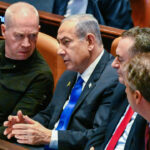Strategists are questioning whether Russia’s use of an experimental missile in Ukraine is just bluster or a new grim chapter in the war. The missile, named “Oreshnik,” was used to strike targets in Dnipro on Nov. 21, launching as many as 36 separate munitions. The nature of this new weapon remains unclear, with conflicting reports about its capabilities and design. The attack has raised concerns among Ukraine and allied leadership, sparking questions about its implications for future strategies and nuclear deterrence. The attack may have been aimed at deterring NATO from supplying additional long-range missiles to Ukraine, as tensions escalate in the region. While the exact details of the missile remain uncertain, analysts are closely monitoring the situation for further developments. The ATACMS system in Bryansk has been deemed nuclear-capable, according to Crespo. He mentioned that the potential addition of a MIRV system would serve as a clear warning to NATO, indicating Russia’s heightened response to what it sees as Western escalations. Crespo, a former Marine officer for the U.S. Defense Intelligence Agency, expressed concerns about the difficulty of intercepting these warheads and the increased risk associated with deploying nuclear-capable missiles under Putin’s revised nuclear doctrine.
Furthermore, Crespo highlighted the potential failure of risk reduction systems like the U.S.-Russia notification system during times of crisis or confusion, emphasizing the volatile and dangerous nature of the situation. With the increasing launch rates of nuclear-capable weapons and minimal communication between adversaries, there is a heightened risk of misinterpreting conventional missiles for nuclear ones and vice versa.
The recent attack by Russia using the RS-26 missile is seen as a symbolic display of defiance against NATO’s support for Ukraine. The spread of nuclear-capable weapons on the battlefield could complicate decision-making for allied nations, especially as the U.S. relies on Russia for advance notification of such weapons’ use to prevent nuclear war. Despite Russia’s advance notice to the U.S. about the recent attack, there have been no adjustments to nuclear postures from either side.
The Biden administration views the attack as a symbolic rather than tactical move, considering the limited number of experimental missiles possessed by Russia. While the weapon may have been used to intimidate Ukraine and its allies, its impact on the battlespace and allied deterrence efforts is expected to be minimal. The U.S. has briefed Ukraine and its allies about the weapon’s potential use, mitigating some of the damage that could have been caused.
As Ukraine continues to receive increased security assistance and support from NATO, the conflict is expected to persist despite Russia’s actions. NATO remains committed to supporting Ukraine, with emergency meetings and discussions taking place to address the situation. The ongoing developments in Bryansk and the surrounding regions underscore the complex geopolitical dynamics at play in the current global landscape. Please rephrase this sentence.
Source link






